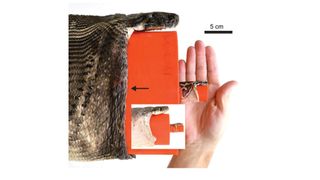Jaw-dropping study reveals how pythons can devour super-size prey
Prey: "What a big mouth you have!" Python: "The better to eat you with."

Burmese pythons are voracious eaters, swallowing nearly anything that crosses their paths — even sizable white-tailed deer and other large mammals. So is there a limit to how far these slithery carnivores can stretch their jaws to snarf down big prey? Maybe not, scientists recently learned.
These pythons are massive compared with other snakes, reaching about 18 feet (5.5 meters) in length and weighing up to 200 pounds (91 kilograms). However, a study published Aug. 25 in the journal Integrative Organismal Biology found that their girth isn't what determines why hungry pythons can devour supersize meals. Instead, the secret lies in the snakes' gape — how widely they can open their mouths.
Biologists from the University of Cincinnati wanted to test just how far euthanized Burmese pythons (Python bivittatus) could stretch their jaws for a snack. It's widely — and falsely — believed that snakes can dislocate or unhinge their jaws to swallow prey. In reality, an elastic piece of connective tissue stretches from the snake's braincase, or cranium, to its lower jaw, thus enabling the animal to gobble ginormous grub.
"The key thing about snakes is that they don't dislocate any joints at all during the process of swallowing their prey," Bruce Jayne, the study's lead author and a biologist and professor at the University of Cincinnati, told Live Science. "But the joints they do have between their bones are extremely mobile. Unlike [human] jaws, which are one piece, in snakes, it's two pieces. And in between those two pieces are connective tissues, skin and muscles."
Related: Largest python ever found in Florida is 18 feet long and weighs a whopping 200 pounds
All of these pieces fit together to form a highly mobile mechanism that allows the nonvenomous pythons to open their mouths wide and engulf their prey. Once an animal is in the snake's grasp, the sinuous predator coils its long body around the victim to constrict its blood flow before gulping it down — whether the victim is dead or still breathing.
Using a series of 3D-printed plastic probes in varying sizes, scientists tested different individual pythons with probes in increasing sizes, measuring the maximum amount that each animal could open its mouth. The largest probe was 9 inches (22 centimeters) in diameter and looked strikingly similar to an orange Home Depot bucket. Only one snake was able to stretch its gape wide enough to accommodate the giant probe: a python weighing roughly 130 pounds (59 kg) and measuring 14 feet (4.3 m) long.
Sign up for the Live Science daily newsletter now
Get the world’s most fascinating discoveries delivered straight to your inbox.

"The probe is big enough to fit over my head," Jayne said. "To give you an idea of how big that specimen was, it's too large to fit inside a 5-gallon [20 liters] bucket. That was a hefty one."
Burmese pythons are plentiful in the Florida Everglades but are an invasive species that decimate local animal populations. For the study, biologists worked with area hunters to access euthanized specimens that had been killed to help reduce the invasive population. This limited the size of the snakes that Jayne and his team could test in their experiments.
"I wish I could've gotten bigger pythons, because one thing people always want to know is what is the biggest gape," Jayne said. "I believe some could have a gape diameter as big as 30 inches [76 cm]."

The study also found that just because snakes have adaptable jaws, not all snake species can open their mouths as wide as a Burmese python can. When the biologists tested the gapes of brown tree snakes (Boiga irregularis) — another invasive species that dines on birds, lizards and small rodents — they found that brown tree snakes, which are about the same length as Burmese pythons but are much less massive, couldn't gape their gobs nearly as much as their bigger Burmese cousins could.
"The magnitude between the two species was surprising," Jayne said. "If you compare gape to mass, the two species would be similar. But the pythons, even after correcting for the fact, are much heavier snakes and still had bigger gapes."
However, Jayne cautioned that just because pythons can open their mouths wide, it doesn't mean all of their meals consist of large mammals. In fact, much of their diet includes smaller game, such as rabbits, foxes and raccoons.
"Snakes' anatomy puts an upper limit of what they can eat, since they don't take bites out of their prey, and instead swallow them whole," he said. "Just because they have that anatomical capacity doesn't mean that they regularly use it. Very often prey can be difficult to capture and swallow. I'm very interested in following up and seeing what their anatomy permits."

Jennifer Nalewicki is a Salt Lake City-based journalist whose work has been featured in The New York Times, Smithsonian Magazine, Scientific American, Popular Mechanics and more. She covers several science topics from planet Earth to paleontology and archaeology to health and culture. Prior to freelancing, Jennifer held an Editor role at Time Inc. Jennifer has a bachelor's degree in Journalism from The University of Texas at Austin.
